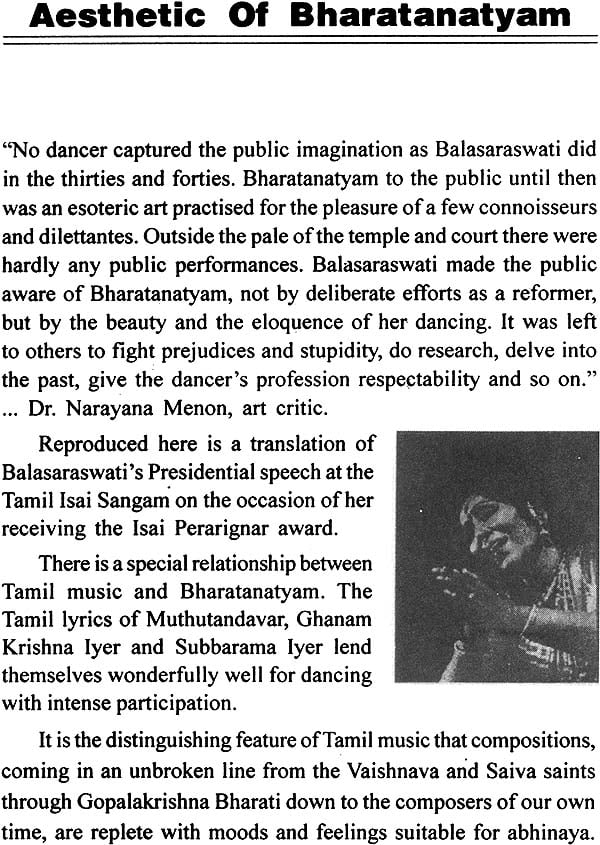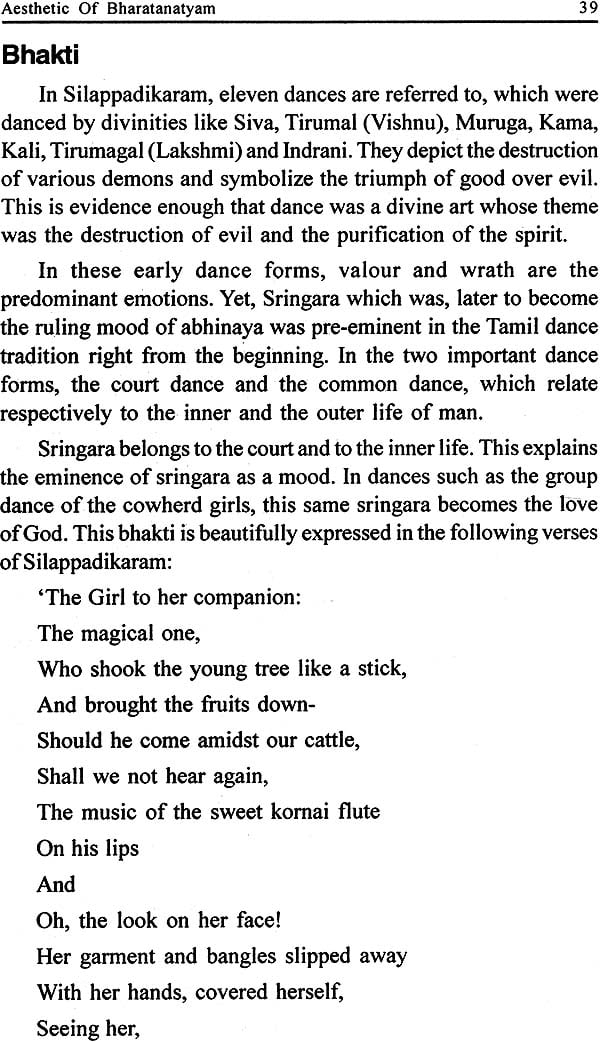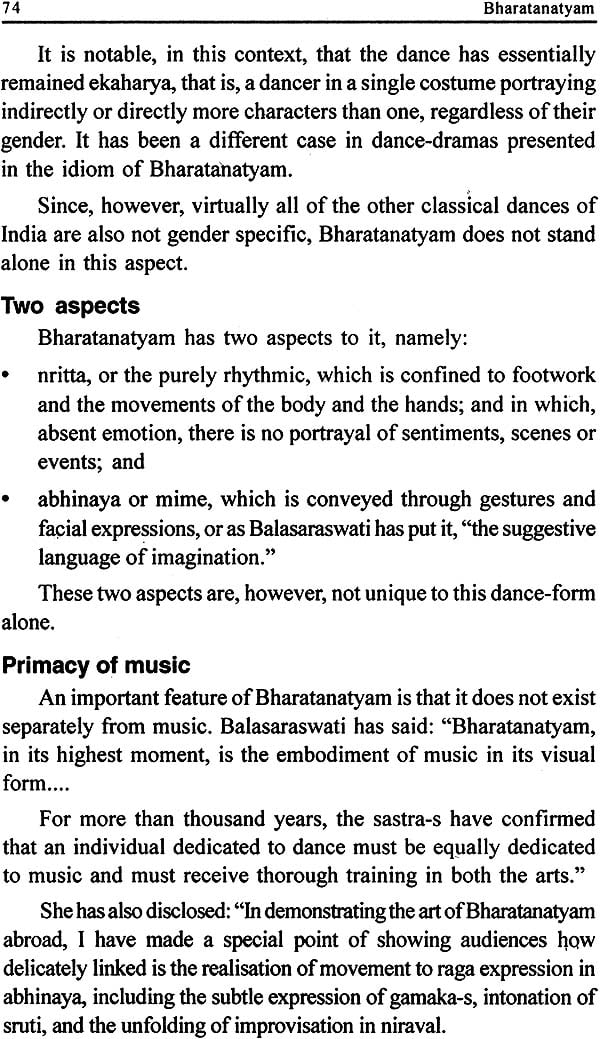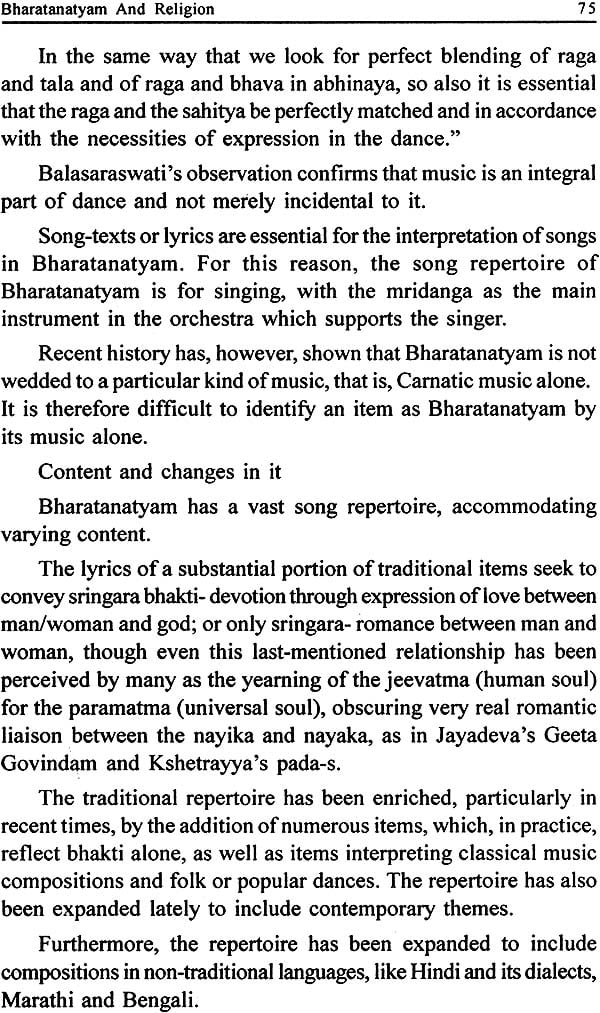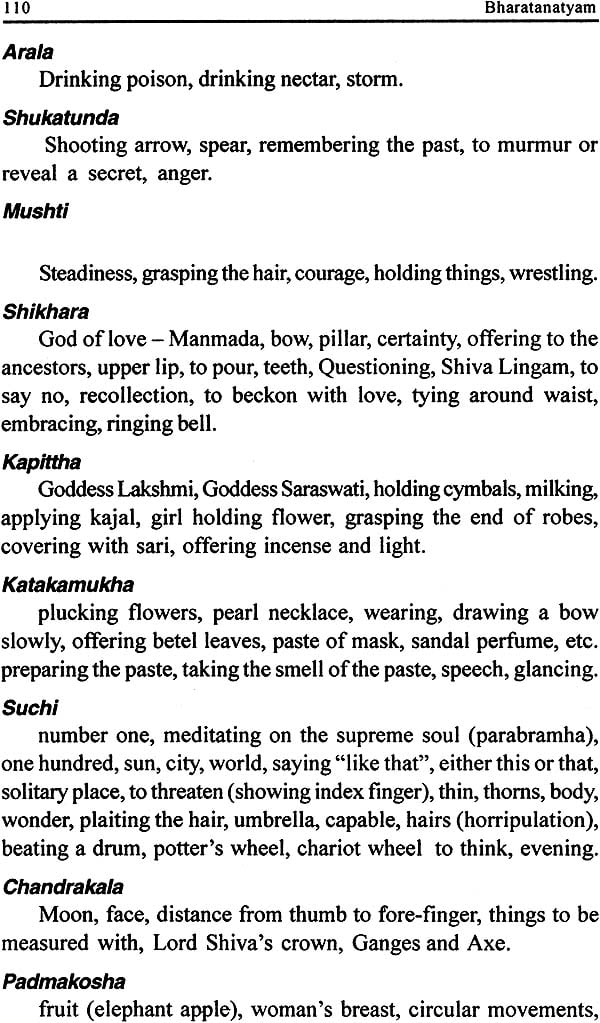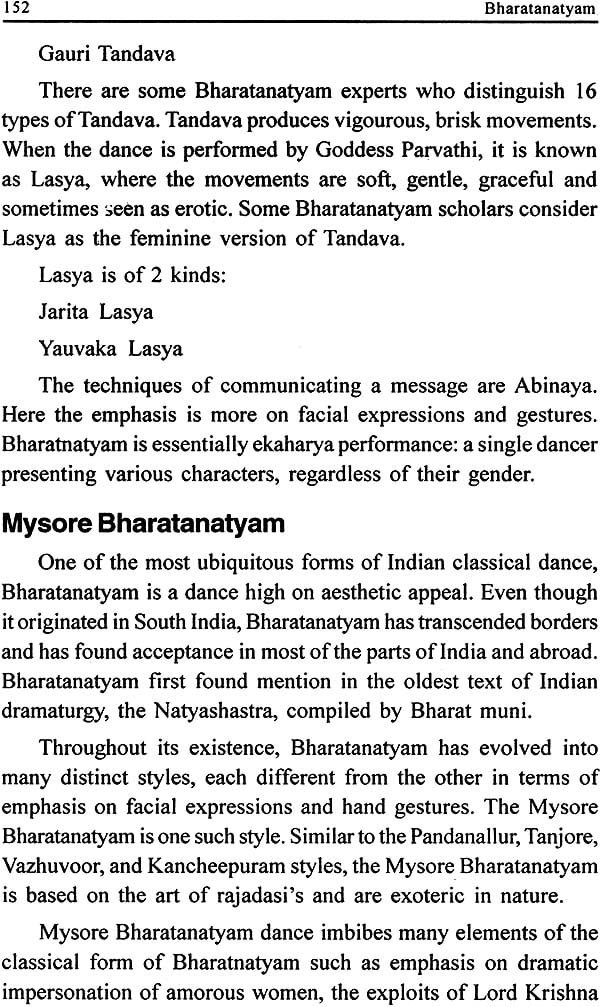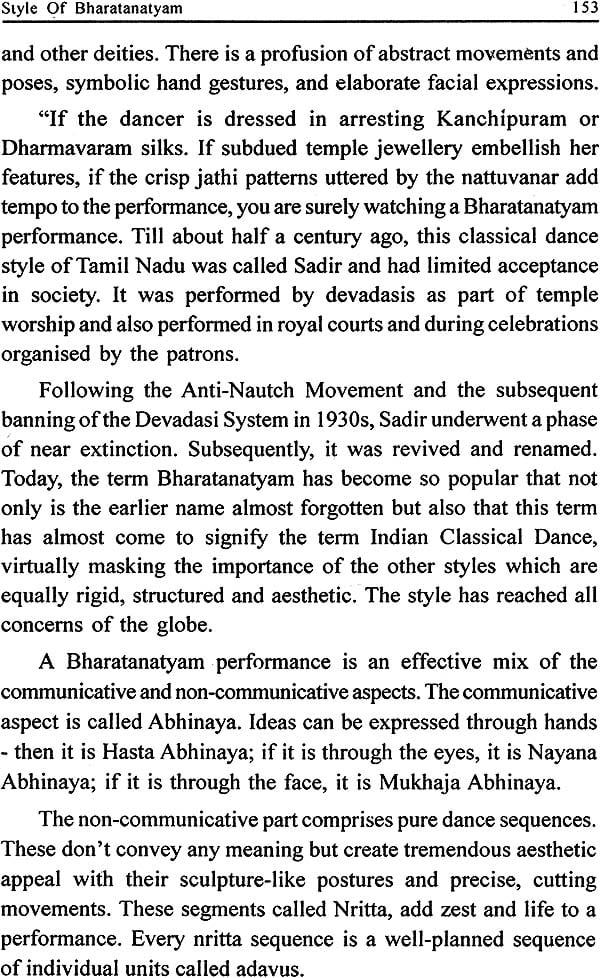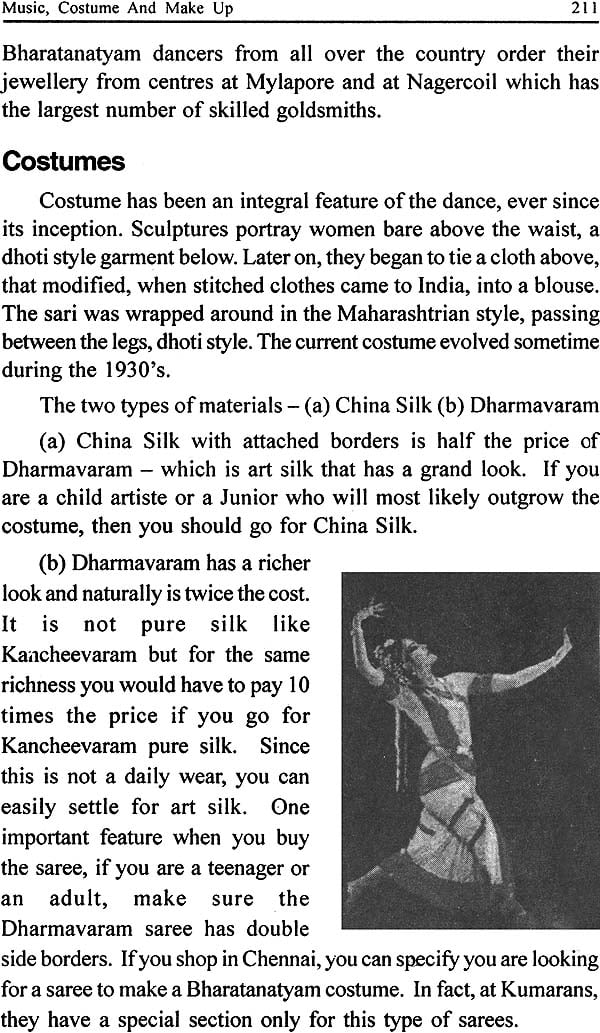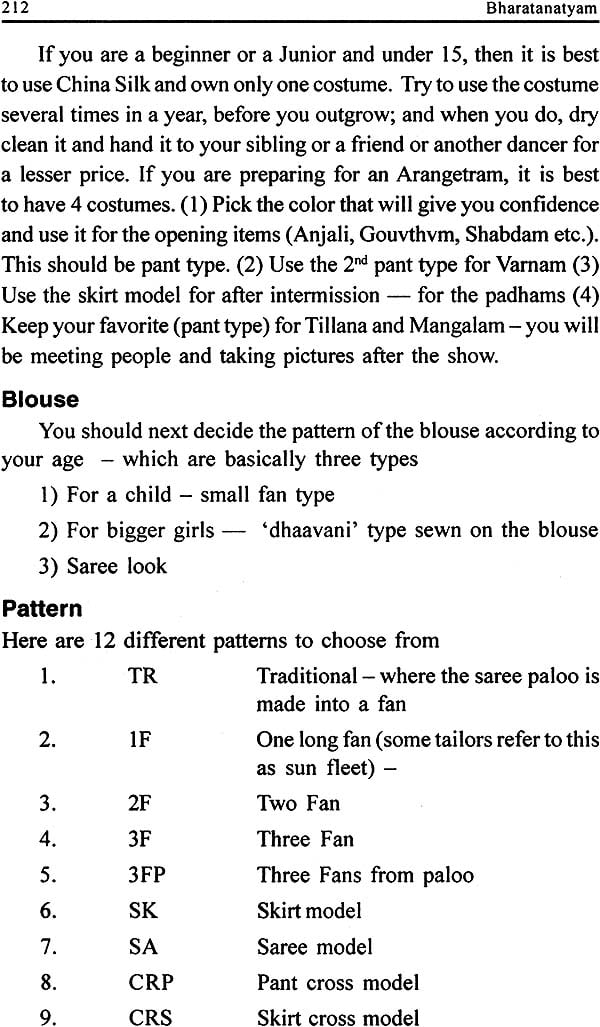
Bharatnatyam
Book Specification
| Item Code: | NAG259 |
| Author: | Dr Micky Verma |
| Publisher: | Abhishek Prakashan, Delhi |
| Language: | English |
| Edition: | 2009 |
| ISBN: | 9788182472396 |
| Pages: | 235 (35 B/W Illustrations) |
| Cover: | Hardcover |
| Other Details | 8.5 inch X 5.5 inch |
| Weight | 440 gm |
Book Description
About the Book
This book takes you on a journey through this beautiful dance form "Bharatnatyam" Originated in Tamil Nadu' this dance form is a reconstruction of Cathir' the art of temple dancers. This book covers various art forms 'mudras' basics fundamentals' etc related to Bharatnatyam.
About the Author
Dr. Micky verma did her ph.D from guru nanak dev University' Amritsar and presently working with APEE Jay college of fine Arts' Jalandhar. Introduction
Bharatanatyam was the dance technique evolved in the South of India in Tamil Nadu and practiced in the temples of Shiva. It is a highly specialized science with a traditional background and rigid codes and conventions. Bharatanatyam skillfully embodies the three primary ingredients of dancing. They are bhava or mood' raga or music and melody and tala or timing. The technique of Bharatanatyam consists of 64 principles of coordinated hand' foot' face and body movements which are performed to the accompaniment of dance syllables.
Bha + ra + ta + natyam=Bharatanatyam Here Bha=bhava or expression' Ra=Ragam or melody' Ta=Talam or rhythm' Natyam Dance' therefore' together is called 'BHARATANATYAM' History Of Bharatnatyam. Bharatanatyam is the oldest of all the classical dance forms of India. Bharatanatyam in its solo form as we see today is indeed an authentic classical dance form. Its origin date back to more than 2000 years when man could see Gods and Goddesses on the earth.
Tamditham tei ta thei. A hush falls over the audience as the silk-clad dancer' bedecked with fresh flowers and jewelry steps onto the stage. In perfect harmony with the recitation the danseuse unfolds the powerful yet gracefully feminine movements.
As the audience is being transported into the world of rhythm and joy' few of them realize that years of rigorous training as well as enormous mental and emotional discipline has gone into the blossoming of the Bharat Natyam dancer.
Many people wonder what the name Bharatanatyam really means. Most of us know that it is the name of one of India's ancient classical dance styles' but few realize that the term Bha-ra-ta implies the triple components of bhava (expressional dance)' raga ( melody) and tala (rhythm) all of which are judiciously combined in this beautiful dance style.
Originally Bharat Natyam was a ritual dance wherein young women occupied the hallowed position of a temple dancer and performed to the accompaniment of a number of devotional songs while giving vivid facial expressions that conveyed the meaning of the accompanying lyrics.
The name Bharatanatyam was given to this dance much later' when it was formally introduced on the stage for the enjoyment of connoisseurs and the general public. It was earlier known as Sadir. Bharatanatyam originated from Tamil Nadu. Earlier' rigid provincial borders did not exist and each great dynasty that ruled in any area spread their powerful empires far and wide. During the time of Vijayanagar dynasty Bharatanatyam absorbed a number of influences of its neighboring state Andhra Pradesh.
Thus the Telegu language of Andhra Pradesh. Forms a substantial part of the background music for Bharatanatyam besides the original songs in the Tamil language. Later' during the early 18th century the Maratha rulers of Tanjore also patronized this dance form by employing female dancers to entertain their royal assemblies.
There were many great composers who were employed in the court of Sarabhoji a noteworthy Maratha ruler' and onnaiah 'Chinnaiah' Sadasivam and Vadivelu. These learned men gave proper shape to Sadir.
Today's Bharatanatyam owes mucgs stylized structure to these four brothers who came to be known as the 'Tanjore Quartet'. From then onwards Bharatanatyam has largely remained in the format that the Quartet had given' though individual variations can be found in the presentations of some contemporary Bharatanatyam dancers.
A recital of Bharatanatyam dance begins with an invocation. This song offers prayers to a certain god or goddess' associated with knowledge' wisdom and auspicious omens' Then the dancer presents the very first item' usually drawn from the ancient temple repertoire' such as a formal offering of flower petals at the altar' followed by an introductory dance sequence showing the basic stances of Bharatanatyam.
This sequence is called pushpanjali (floral offering) and alarippu (introductory sequence). The second sequence is a melody and rhythm combination (jathi swaram) wherein complicated techniques (footwork' body movements' hand gestures all combined) are performed with a serene expression' to a series of musical notes. There is' notably' no story telling or facial expression in this sequence.
The third piece presented is usually a sabdam. This is a form of singing in which a popular legend or myth is told in a simple meter. Accordingly' the dancer conveys through facial expressions' the contents of the lyrics. The fourth item is one that occupies the central position of the concert' in which the dancer's concentration' stamina and artistic competence are all put to test. This is a dance called Varnam. Varnam is a complicated edifice which starts with an impressive rhythmic passage' leading on to mimetic sequences and concluding in a faster tempo.
The dancer is expected to alternate technique and facial expressions effectively while maintaining the emotional intensity of the song. Varnam is danced for duration of 40 minutes one hour by accomplished dancers. After a brief rest of minutes' the Bharatanatyam performance is resumed with Ie and slow paced love songs and devotional songs to which the dancer gives appropriate expressional interpretation.
This part of the dance is called abhinaya and the songs- known as padams and javalis. One must not be misled into thinking that these are by any means' easy to perform. To the connoisseurs dance abhinaya represents the real essence of Bharatai and a dancer is acknowledged only after she has master aspect.
More mature dancers are expected to freely improvise expressions and give unusual and varied interpretations common songs. Thus abhinaya tests authority of an artist. Having satisfied the highest aesthetic demands of the connoisseurs' dancer ends the performance with a fast and sparkling thillana which' once again rapid footwork' pleasing body postures and techniques of Bharatanatyam are presented. In this manner contemporary performer of this ancient classical dance pre and portrays all aspects of the dance style.
The question always arises as to how individual contributions of various teachers and dancers can figure in a rigidly s form. A sensitive audience usually welcomes any innovative falls within the-norms of a classical style but rejects those which spoil the familiar beauty of such as a style. So' innovative dancers have a great challenge to meet and always try to work within the precincts of their chosen style of dance.
A Bharatanatyam dancer wears a specially made cost brightly coloured silk' bordered by gold thread work. In olden a silk sari of 8 or 9 yards would be wound elaborately around the dancer's body' and tucked in several places. Now' this same costume' is stitched by special tailors' is easier to wear and drapes better: The dancer also takes less time to change into different costumes. Every limb of the dancer is adorned with traditional
Jewelry made of semi precious stones set in gold leaf. The hair is made into a single long braid and decorated with flowers. The ankle bells worn by the dancer (numbering from 30 to 50 on each ankle) make musical sounds that emphasize her foot beats' (but a good dancer must never be caught on the wrong foot.
The accompanying singer may be female or male and one or more drummers may be engaged for the performance. They play the mridangam (a cylindrical drum placed in the horizontal position); ghatam (the earthen pot placed in an inverted position and tapped rapidly; the kanjira (a leather bound tambourine) and other drums. A flautist ad violinist also features in the orchestra.
One of India's most ancient string instruments is the Veena. Two dried gourds are connected with a long hollow wooden stem at opposite ends. Four strings are stretched over frets and affixed on the wooden stem. By pressing the strings with one hand and strumming them with the other every note that the singer sings is reproduced sonorously by the Veena player.
Veena forms a part of the orchestra of Bharatanatyam. But the pride of place is occupied by the conductor of the orchestra. He or she is usually the guru (teacher) who has coached the dancer' though professional orchestra conductors are also engaged from time to time by senior dancers who have graduated to work independently. The conductor wields a pair of brass cymbals' which he claps together and at the same time utters rhythmic sound-syllables matching with the foot beats of the dancer.
This continuous stream of strong and often rapidly pronounced syllables has no linguistic translation other than in dance terms. This technique is known as nattuvangam and the conductor is called the nattuvanar. Modem day dancers may keep up their practice with taped music though a live orchestra is always preferred. But professional level concerts give results only when a live orchestra is playing' as is the usual practice in India.
A Bharatanatyam dancer also learns various methods of applying facial make up' selecting and adjusting jewelry and costumes etc.' as well as a wardrobe manager or makeup man can. The dancer learns methods of selecting appropriate items for a particular concert' the tempo suitable for each item' with her knowledge and experience. Bharatanatyam in India has traveled a long way since the time of its days in the temples.
Today it is a complex performing art learnt over a period of at least six years' which also serves the social purpose of knitting together the cultural identity of the young and old generations. It is famous both at home and abroad. A number of academies have come up though individual tuition is also given. Many young women and men' from various parts of India and the world' flock of Tamil Nadu to acquire training in Bharatanatyam.
For many centuries Bharatanatyam has been performed only by certain families in the district of Tanjore' these inheritors of the craft being known as 'Nattuvans'.
The chief exponents of this dance were the Devadasis or temple dancers. They would perform the dance daily at the time of worship or on festive occasions. It came to be patronized by the Rajas and princes. In course of time Devadasis started dancing in the royal courts and thus its religious sanctity was lost.
Bharatanatyam is a classical dance form originating from Tamil Nadu' a state in Southern India. This popular South Indian dance form called Bharatanat is 20th century reconstruction of Cathir the art of temple dancers. Cathir in turn' is derived from ancient dance forms. The word Bharata' some believe' signifies the author of the famous Sanskrit treatise on stagecraft called Natya Shastra and the word Bharatanatyam is sometimes given a folk etymology as follow:
Contents
| Introduction | 5 |
| Aesthetic of bharatanatyam | 38 |
| Bharatanatyam and religion | 72 |
| Bhartanatyam the origins | 100 |
| Style of bharatanatyam | 128 |
| Techniques of bharatanatyam | 156 |
| Performance of bharatanatyam | 179 |
| Music' costume and meke up | 204 |
